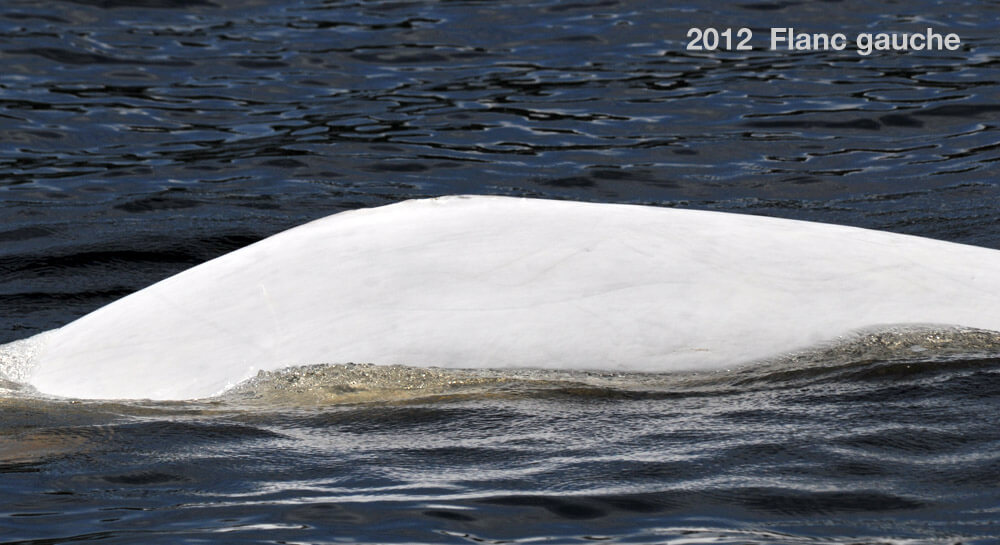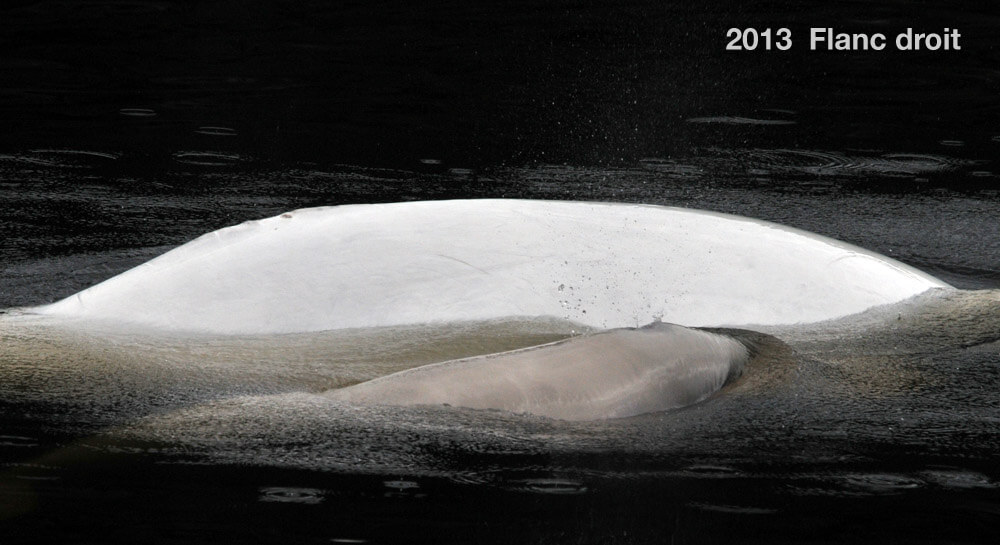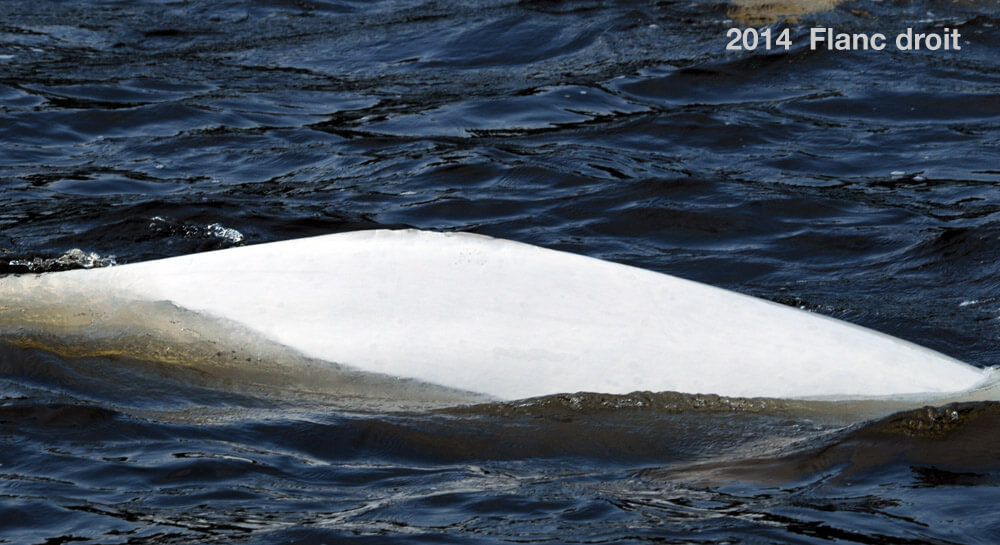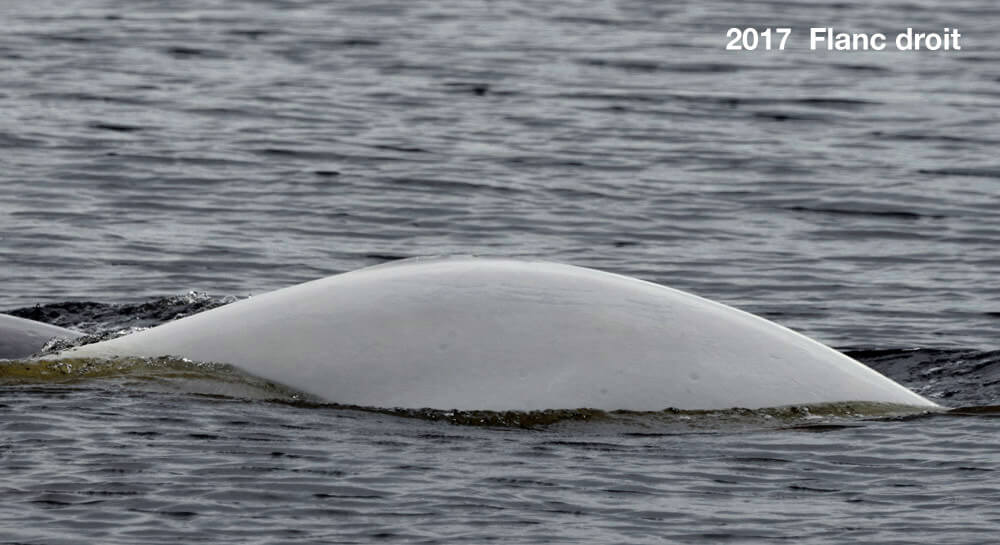Artsea
Beluga

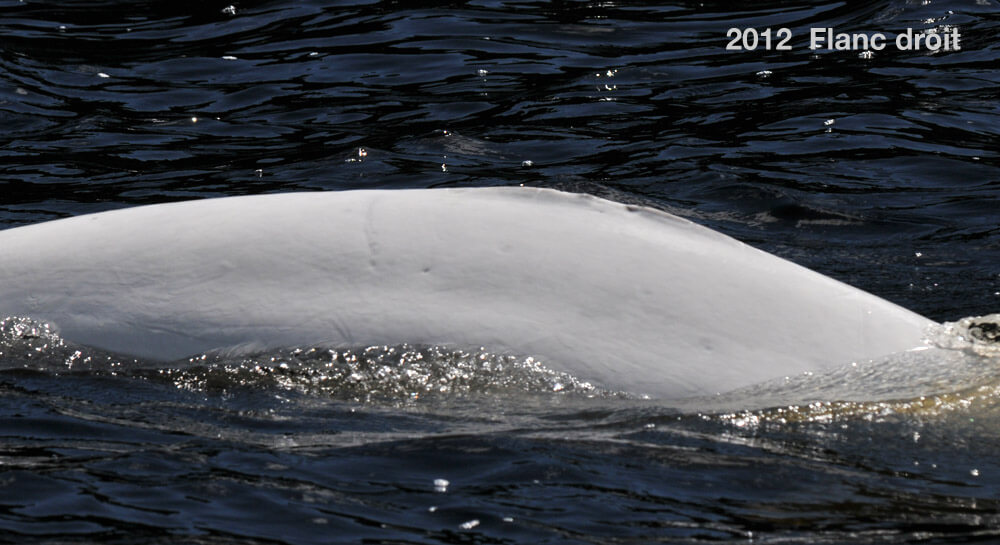
Adopted by the clientele of Maison Simons
-
ID number
DL1903
-
Sex
Unknown
-
Year of birth
Circa 2000
-
Known Since
2002
Distinctive traits
Artsea’s crest is recognizable from both sides by its two large jagged gashes. On the left flank there is a black spot where the two gashes end. Its right flank shows a white line and a spot at the beginning and end of the gash.
Life history
At the time of our first encounter, Artsea was gray and small, signs that it was still very young. When we observed it most in 2015, it was still slightly gray, but had reached its adult size. The transition from gray to white in belugas generally occurs between between the ages of 12 and 16 years. All this leads us to believe that Arsea is approaching its twenties.
Its size and its associations suggest that Artsea is a female. In their summer range, females form large communities in which they care for newborns and young. Artsea has been regularly seen in groups of juveniles and adults, some of which were accompanied by calves. It was also observed with a newborn in 2013, but it is impossible for us to say whether it was its own!
How Artsea’s story unfolds will help us better understand the social and reproductive lives of belugas. By better understanding how belugas live, we will be able to better protect them.
Observations history in the Estuary
Years in which the animal was not observed Years in which the animal was observed
Latest news
Installed on the La Halte du Béluga lookout in Fjord-du-Saguenay National Park, GREMM’s research assistant waits in the hope that belugas will come to socialize in Sainte-Marguerite Bay. Surveys carried out by Parks Canada have shown that belugas are present in this bay 66% of the time during the summer. So when a herd of 20 belugas enters the bay, it’s busy! The belugas come in small groups of three to six, most of them adults, with a few younger belugas still grey-skinned. Then a few more arrive, this time accompanied by a calf. One of the females in the group is easily recognizable by her deformity: it’s Pascolio. Another has beautiful markings on her crest. This is Artsea. Both are regular visitors to Baie Sainte-Marguerite, where they are photographed almost every summer. On the surface, tails and pectoral fins split the waves. Are the belugas playing? Are they teaching their young hunting techniques in the shallow waters? For three hours, the belugas are busy, before they all leave at the same time! There’s so much more to learn about beluga whale activity.
Our research assistants undertook the meticulous analysis of some 13,000 photos collected throughout the summer of 2018. Thanks to this exercise, we were able to conclude that we spotted Artsea at least five times, including four sightings in the Saguenay! Below is an account of one of these encounters.
Today, we’re heading up the Saguenay on board the Zodiac-like research craft BpJAM. We are carrying out a project that aims to study beluga behaviour with the help of drones. Mathieu operates the craft and photographs the belugas while Albert flies the airborne camera whenever needed. A herd of belugas moves in behind the Zodiac. We observe: the animals are mostly juveniles. We also identify a newborn. Given that calving takes place in July, it must be just a few days or a few weeks old. Amongst the females present we identify Artsea and Dorothy. Last year, Artsea gave birth to a calf; will we manage to recognize her offspring in this group? We release the drone to observe the animals, but the wind picks up. Part of the herd moves deeper into Baie Sainte-Marguerite. This year, watercraft are forbidden from entering the bay in an effort to offer belugas a peaceful sanctuary. Fortunately, the team posted on top of the tower can photograph them for us. A new group joins the heard, which brings our count up to 35 individuals.
The Bleuvet is sailing between Pointe Noire and Îlet aux Alouettes. Waves of about a foot high rock the boat and a 15 km/h wind picks up. Nevertheless, visibility is a good 5,000 metres and gives us hope of spotting belugas from afar. Incidentally, a herd of about fifteen individuals appears on the horizon. Among them, we can make out adults, young and two café-au-lait-coloured newborns. The animals are diving in every direction, forcing us to focus on one small group. Good news! Artsea is swimming with a newborn at its side, together with three adults, another newborn, and a sizable young gray. Quickly, we must return to the marina, as our chief technician Michel Moisan needs to prepare for his departure for Alaska, where together with Robert Michaud he will lend a hand to a team of researchers studying the belugas of Cook Inlet.
Artsea is at the mouth of the Saguenay Fjord. It is swimming in the company of some thirty individuals. The herd is composed of adults and juveniles, including Blanchon, a female from the Saguenay community. At first the animals are in two distinct groups, but eventually the animals splinter off into pairs. With the animals scattered all around, collecting data is not so straightforward. After 3 hours with the herd, it begins to pour and we return to port. We haven’t spent much time in the field , but a lot of lab work lies ahead.
Sponsor
The clientele of Maison Simons adopted Twik (1990) and Artsea (2017). Shop the collection created for the adoption of Artsea. To find out more about the love story between belugas and Simons, click here.

